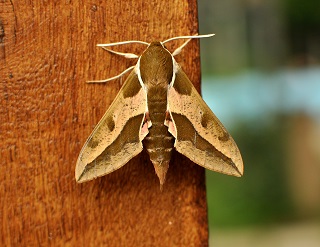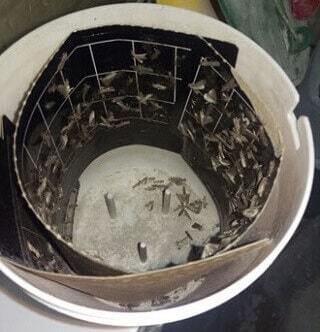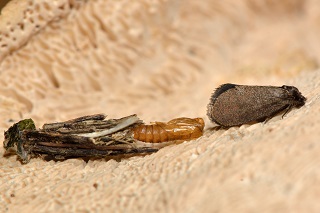A moth infestation is like a wolf dressed in sheep's clothing. While in comparison to other pests it may appear to be seemingly harmless, it can cause grave monetary damage as well as expose you to health hazards.
In case you're wondering how it might result in a drain on your finances - think about which parts of your home you may find this breeding infestation. The pantry? Well, that's where you store your food stock. The kitchen? It's the place where all your consumables come from. Your clothes cupboard? Let's not even start to calculate the amount invested to acquire those clothes. Your beautifully carpeted living room? The carpet, upholstered seating arrangements, etc., they blend in seamlessly, but that also means that a moth infestation wouldn't just destroy one item but rather ravage through the entire collection through a chain reaction.
Any homemaker will agree that no pest is permitted to enter their home. But preventing a moth infestation all by yourself can be way too difficult. With all the details involved in the inspection, attempting to control the existing population, and prevention, it is best to let a professional deal with the issue.
If you are still considering whether you can handle the situation by do-it-yourself techniques, here's how employing professional moth control can be a game-changer, speed up the process and yield far more effective results.
Identifying the Moths, Signs of an Infestation, and Causes With Pest Control Professionals
Which Type of Moth has Taken Over Your Home?
While most of us tend to bracket moths as one type, experts will tell you that there are different types. And this is important because it helps set a customised plan of action in tackling them. While most moths are nocturnal insects and are known to be drawn to light, there can be differences in their habit, habitat, and diet, and that's where the expertise of a pest control professional comes into play.
Signs of an Infestation
 Moths seem to make their way into every room. The kitchen, pantry, any room with carpets and of course the clothes and linen cupboard are where you might find their homes.
Moths seem to make their way into every room. The kitchen, pantry, any room with carpets and of course the clothes and linen cupboard are where you might find their homes.
Some signs of a moth infestation that can be easy to spot are, seeing moths make headway to the lights or bulbs, holes in your clothes and linen, you may spot them fluttering around in your kitchen and pantry. You may even see moth larvae crawling over flat surfaces or on your carpet.
Mind you, these may be obvious signs of an infestation, however, there may be other tell-all signs that professionals will notice during the inspection to devise a control treatment.
Identifying a Moth's Entryway into Your Home through a Professional's eye
The first question an expert will ask you is whether you close your doors and windows once evening hits. If you absolutely can't compromise on ventilation, getting fly screens/mesh would be an excellent way to enjoy the breeze as well as keep the insects outdoors once the night sets in.
Another important aspect to consider is whether you have any leakage issues or structural damages in your homes. Any cracks and crevices could also act as an entry point.
Plus, since your home is bound to provide a warm environment and would be well-stocked with food sources (in your kitchen/pantry or clothes wardrobe), the moths are bound to make your home their home. But that's only if you delay treatment.
Without Professional Pest Control, you're Setting Yourself up for Great Damage
A moth infestation can do damage to many things in your home. While cloth moth larvae can make a mess of your clothes, carpet, and upholstery, other moths can get into your food stock of grains and other packed items, thereby making them not consumable and requiring you to throw them up.
Additionally, remember that the presence of moths also brings on their predators like spiders. And well, most of us would do anything to prevent spiders from entering our homes, so tackling a moth infestation at the earliest is of prime importance.
Tackling Moths Hidden in Your Closet
Forget about skeletons in the closet, moths living in your closet are a greater nightmare. Besides the alarming terror of opening the clothes cupboard to have one fluttering in your face, there's also the damage they would do to your clothes by making holes in them.
Inspect your closet thoroughly. This will include having to bring out all the items in your closet so that you can disturb their cozy habitat and make them feel unwelcome. Lightly dust each garment in case any moths are hiding in between the folds.
Additionally, look out for any cloth moth larvae stuck to the garment. Clothes which have holes in them will require a good wash before you can start mending them (if there's the hope of that).
As for clothes with larvae on them, they will have to be treated to control the moth population and prevent the infestation from returning. Now, that you have emptied the closet, thoroughly clean it out to ensure no eggs or moths are stuck in any crevices or sections.
You can also rub it down with a slightly damp cloth which has a little (very little) disinfectant in it. Not only will the odour act as a deterrent but it will also ensure the closet is cleaned out thoroughly of any remains.
Finally, inspect all the corners, carvings, drawers, sections, etc. to see nothing has been left behind. Don't forget to allow the cupboard to air out so that no moisture gets trapped inside. This is important before you put the clothes back in to avoid any other insect infestations from appearing.
Tips For Future Prevention and Control of Moths in the Closet
- Ensure all clothes are properly washed and dried before you put them into the closet. Keep a lookout for moth eggs that might have travelled on your clothing into your home. Avoid putting dirty clothes into your closet, at all cost (even if you think you've barely used them for a few hours).
- All winter clothes must be placed in plastic bags first and then stored away to avoid moths from reaching them and starting their infestation all over again.
- Place a cedar or lavender fragrance among your clothes or let it hang in your closet. Besides the fact that it'll make your garments smell great. the fragrance also acts as a deterrent.
Encountering a moth infestation in your kitchen? Here's a step by step breakdown of how experts will tackle it.
 As mentioned above, inspection is crucial to analyze the extent of the damage, which species is present, etc. Experts will look for droppings in food packages, a distinct odor, any fallen wings, cobwebs, etc. to identify the nest.
As mentioned above, inspection is crucial to analyze the extent of the damage, which species is present, etc. Experts will look for droppings in food packages, a distinct odor, any fallen wings, cobwebs, etc. to identify the nest.
Now while these may be things you too can keep a lookout for in your kitchen and pantry, experts will also look for moth secretions on or under any of the cabinets or storage spaces in your kitchen/pantry. These secretions are a sticky liquid substance left behind and are a quick giveaway indicating their presence.
Bearing in mind the species from where moths originate, experts (or you for that matter) may even chance on caterpillars.Since all the above signs can be present, you can imagine why it's so important to have a professional carry out an inspection and locate these signs.
Secondly, experts will proceed to point out infested and spoilt food, which you must throw out. Needless to say, you should not even try salvaging it because you cannot know the extent to which the moths have infested and spoilt the food, and would be exposing yourself to health hazards by consuming it. Professionals may also leave certain 'traps' to measure how vast the pest population is or to identify where they may be hiding.
Finally, it is important for you to thoroughly clean out your kitchen. Experts will help clean out any eggs or moths in the making to ensure complete removal. However, after the inspection and the pest control treatment there may be remnants of the pest. For hygiene purposes as well as to ensure the effectiveness of the treatment, remember to clean out the kitchen after the treatment as well as from time to time. This practice helps make your kitchen and pantry less and less comfortable for pests to live in.
Tips to Avoid a Return of the Infestation in the Kitchen
- All food must be stored in the refrigerator and not left open. Easy access to food sources only encourages insects to keep coming back for more. Remember, tightly sealed containers are your best friends.
- Warm and humid places are favourite hangout spots for moths. The kitchen and pantry can tend to become warm and humid, however, it's up to you to keep the humidity in check. Keep the rooms well-ventilated. Fix any leakages or plumbing issues and clean up spills immediately.
- Maintenance is another key step in preventing the infestation from returning. Seal up cracks and crevices as often insects can use them as a safe passage to invade your home. And well, not only are you then taking them on in huge numbers but are also enduring the risk of having graver pests like rodents and cockroaches.
- Once again you can add a cedar and/or lavender fragrance to the room to avoid a musky smell and to also deter the pests.
Controlling a Moth Problem in Your Carpet Area
 Carpets are a beautiful addition to a living space. However, they need to be clean and well-maintained, only then do they serve their purpose. And moths can prevent this from happening. If you spot moth larvae an adult moth or even moth holes in your carpet, there is a 98% chance you have an infestation to hand.
Carpets are a beautiful addition to a living space. However, they need to be clean and well-maintained, only then do they serve their purpose. And moths can prevent this from happening. If you spot moth larvae an adult moth or even moth holes in your carpet, there is a 98% chance you have an infestation to hand.
Start by inspecting the area. Look closely all around the carpet as well as under it so you can assess how big a population you are dealing with. Holes, droppings, and webbings are sure shot signs of an infestation and mean you should call the professionals for a thorough examination at the earliest.
Make use of a vacuum to clean up dust, dirt, debris, moths and moth larvae. Vacuum it on top, underneath as well as around it. When clearing the vacuum bag do ensure you do it outside the house and put it in the trash bin immediately. Do so carefully to avoid any of the moths from getting back into the house.
Finally, request professional moth control treatments to ensure the problem is completely taken care of and won't return in the future.
Delaying the treatment of an infestation can cause great damage to your home as well as make you and your loved ones ill. Do not take it lightly or rely on over the counter products to do the problem instead schedule an appointment with a certified service that offers a guarantee-backed job.